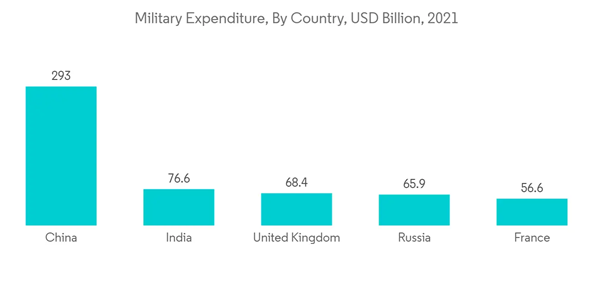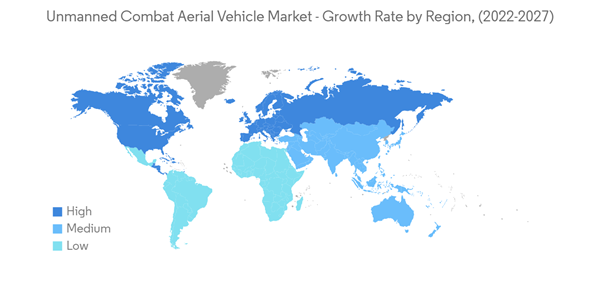The unmanned combat aerial vehicle (UCAV) market is expected to grow at a CAGR of more than 8% during the forecast period.
The defense sector has witnessed the mild impact of the COVID-19 pandemic. The global defense expenditure showed significant growth even during the pandemic. According to the Stockholm International Peace Research Institute (SIPRI), the total global military expenditure rose to USD 1,981 billion in 2020, an increase of 2.6 percent from 2019. The growth in defense expenditure continued in 2021 with a total global defense spending surpassing USD 2 trillion.
An unmanned combat aerial vehicle (UCAV) is also known as a combat drone used for intelligence, surveillance, reconnaissance (ISR), and target acquisition. The UACV carries aircraft ordnance such as ATGMs, missiles, and bombs in hardpoints for drone strikes. These drones are usually under real-time human control and can be used for both battlefield intelligence and drone strikes. Furthermore, combat drones offer an unprecedented ability by increasing accuracy, reducing the risks to civilians, and protecting military personnel from harm.
The increasing defense budgets and the territorial disputes between many nations, particularly in the Asia-Pacific and the Middle East & African regions, are the major reasons for the development of combat UAVs. Growing spending on procurement of next-generation drones due to rising warfare situations, political disputes, and cross-border conflicts among neighbouring countries. With the increasing demand for combat drones, companies and governments are investing in new and innovative UCAVs, with advanced target detection and identification capabilities. Thus, increasing defense spending and procurement of advanced combat drones drive the growth of the market during the forecast period.
For instance, in July 2022, Defense Research and Development Organisation (DRDO) in India successfully conducted the first flight test of the autonomous flying wing technology demonstrator at the aeronautical test range in Karnataka. It was the major milestone of DRDO scientists towards developing an unmanned combat aerial vehicle of flying wing type. It was the precursor to an autonomous UCAV being developed by the DRDO’s Aeronautical Development Establishment (ADE), for the Indian Air Force. Thus, growing expenditure on the design and development of next-generation fixed-wing combat drones drives the growth of the market during the forecast period.
For instance, in May 2022, XTEND, an Israeli defense company signed an agreement with the United States Department of Defense to supply hundreds of new Wolverine Gen2 drones to the United States military. The drones will be used to protect ground troops on dangerous missions. The Wolverine drones are lightweight with lower power consumption than other small unmanned systems. Thus, increasing investment in the procurement of advanced combat drones will boost market growth across the region in the coming years.
Several players are involved in designing and developing unmanned combat aerial vehicles due to increased funding by the governments of the respective countries. The development of new UAV payloads that help in increasing the lethality of the drones, with better target-hitting capabilities, will also support the growth of the UCAV market. The strategic investments by the key OEMs for expanding their global presence are expected to increase their market shares in the UCAV market. For instance, in April 2022, Turkey’s new unmanned combat aerial vehicle AKINCI, developed by Baykar, engaged a sea target with an MK-82 bomb fitted with a TEBER guidance kit.
This product will be delivered within 2 business days.
The defense sector has witnessed the mild impact of the COVID-19 pandemic. The global defense expenditure showed significant growth even during the pandemic. According to the Stockholm International Peace Research Institute (SIPRI), the total global military expenditure rose to USD 1,981 billion in 2020, an increase of 2.6 percent from 2019. The growth in defense expenditure continued in 2021 with a total global defense spending surpassing USD 2 trillion.
An unmanned combat aerial vehicle (UCAV) is also known as a combat drone used for intelligence, surveillance, reconnaissance (ISR), and target acquisition. The UACV carries aircraft ordnance such as ATGMs, missiles, and bombs in hardpoints for drone strikes. These drones are usually under real-time human control and can be used for both battlefield intelligence and drone strikes. Furthermore, combat drones offer an unprecedented ability by increasing accuracy, reducing the risks to civilians, and protecting military personnel from harm.
The increasing defense budgets and the territorial disputes between many nations, particularly in the Asia-Pacific and the Middle East & African regions, are the major reasons for the development of combat UAVs. Growing spending on procurement of next-generation drones due to rising warfare situations, political disputes, and cross-border conflicts among neighbouring countries. With the increasing demand for combat drones, companies and governments are investing in new and innovative UCAVs, with advanced target detection and identification capabilities. Thus, increasing defense spending and procurement of advanced combat drones drive the growth of the market during the forecast period.
Unmanned Combat Aerial Vehicle Market Trends
Fixed-Wing Segment is Projected to Show Significant Growth During the Forecast Period
The fixed-wing segment of the market has the highest market share and is expected to register the highest CAGR during the forecast period. The growth is attributed to the increase in investments in the development of delta-wing and complex delta-wing UCAVs, with advanced combat capabilities, that can fly at supersonic speeds. Countries, like the United States, India, China, Iran, Israel, and Russia, among others, have invested in such combat UAVs. China is using stealth technology in unmanned platforms and is unveiling more UCAV variants. Furthermore, rising global expenditure and rising spending in enhancing defense capabilities drive market growth.For instance, in July 2022, Defense Research and Development Organisation (DRDO) in India successfully conducted the first flight test of the autonomous flying wing technology demonstrator at the aeronautical test range in Karnataka. It was the major milestone of DRDO scientists towards developing an unmanned combat aerial vehicle of flying wing type. It was the precursor to an autonomous UCAV being developed by the DRDO’s Aeronautical Development Establishment (ADE), for the Indian Air Force. Thus, growing expenditure on the design and development of next-generation fixed-wing combat drones drives the growth of the market during the forecast period.
North America is Expected to Lead the Market During the Forecast Period
North America held the highest market share in the unmanned combat aerial vehicle market and continue its domination during the forecast period. The growth is attributed to the highest defense expenditure, growing focus on improving military capabilities, and procurement of next-generation combat drones. The United States is the highest defense spender in the world in 2021. The United States Department of Defense (DoD) allocated about USD 7.5 billion in 2021 for a variety of unmanned systems and related technologies. Furthermore, the United States Department of Defense requested USD 1 billion for the procurement of 3 MQ-4 Triton unmanned aerial vehicles in the fiscal year 2023 defense budget. Thus, rising defense expenditure and increasing adoption of next-generation combat UCAVs for strengthening defense capabilities drive market growth across North America.For instance, in May 2022, XTEND, an Israeli defense company signed an agreement with the United States Department of Defense to supply hundreds of new Wolverine Gen2 drones to the United States military. The drones will be used to protect ground troops on dangerous missions. The Wolverine drones are lightweight with lower power consumption than other small unmanned systems. Thus, increasing investment in the procurement of advanced combat drones will boost market growth across the region in the coming years.
Unmanned Combat Aerial Vehicle Market Competitor Analysis
The unmanned combat aerial vehicle market is fragmented in nature with the presence of several global and local players holding significant shares in the UCAV market. Some prominent market players are Boeing, General Atomics, Israel Aerospace Industries Ltd, Northrop Grumman and Lockheed Martin Corporation.Several players are involved in designing and developing unmanned combat aerial vehicles due to increased funding by the governments of the respective countries. The development of new UAV payloads that help in increasing the lethality of the drones, with better target-hitting capabilities, will also support the growth of the UCAV market. The strategic investments by the key OEMs for expanding their global presence are expected to increase their market shares in the UCAV market. For instance, in April 2022, Turkey’s new unmanned combat aerial vehicle AKINCI, developed by Baykar, engaged a sea target with an MK-82 bomb fitted with a TEBER guidance kit.
Additional benefits of purchasing the report:
- The market estimate (ME) sheet in Excel format
- 3 months of analyst support
This product will be delivered within 2 business days.
Table of Contents
1 INTRODUCTION
4 MARKET DYNAMICS
5 MARKET SEGMENTATION
6 COMPETITIVE LANDSCAPE
Companies Mentioned (Partial List)
A selection of companies mentioned in this report includes, but is not limited to:
- General Atomics
- Dassault Aviation
- BAE Systems PLC
- Israel Aerospace Industries Ltd
- China Aerospace Science and Technology Corporation
- Lockheed Martin Corporation
- Northrop Grumman
- BAYKAR
- The Boeing Company
- Elbit Systems Ltd
- Kratos Defense and Security
- BlueBird Aero Systems Ltd
Methodology

LOADING...










